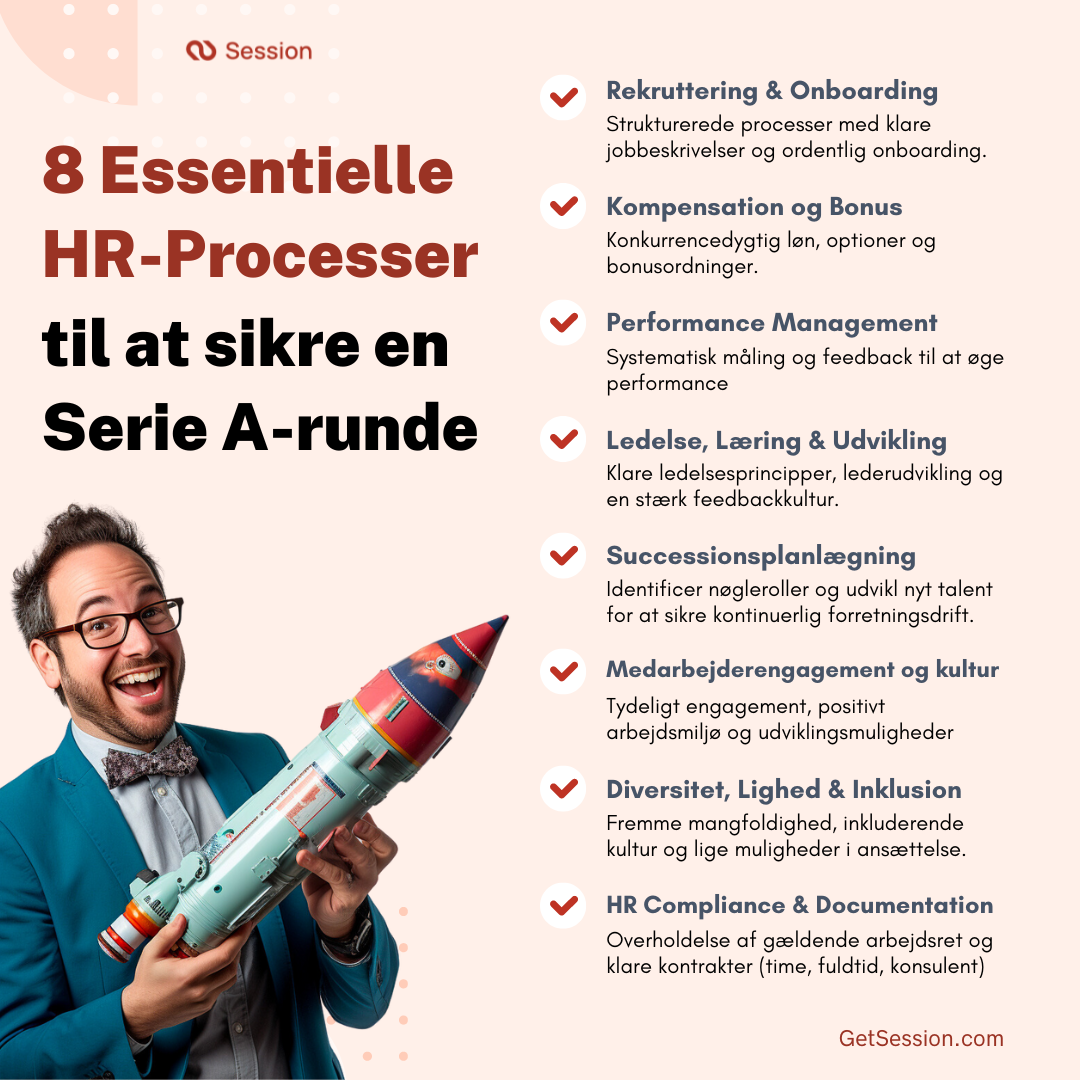Når en virksomhed søger en Serie A-investering, er det vigtigt at bestemte HR-processer er på plads for at vise potentielle investorer, at virksomheden har et stærkt fundament og er godt forberedt til vækst. Vigtige HR-processer, som en virksomhed bør have på plads til Serie A runden, inkluderer:

- Rekruttering og onboarding: Virksomheden bør have en rekrutteringsstrategi, der er i tråd med virksomhedens vækstplaner. Derudover skal der være en struktureret rekrutterings- og onboarding-proces for at sikre, at virksomheden kan tiltrække og ansætte de største talenter. Dette forudsætter klare jobbeskrivelser, en jobnivelleringsramme, gode effektive stillingsopslag, velstrukturerede job-interviews og en grundig onboarding-proces så man hurtigt kan få de nye medarbejdere op i gear.
- Kompensation og bonus: Med udgangspunkt i jobnivelleringsramme bør virksomheden have en transparent løn- og bonuspakke for at tiltrække og fastholde top-talenter. Dette inkluderer en kombination af løn, aktier og fordele som fx. ekstra sundhedsforsikring, barselsorlov og andre goder. Lønpakker skal regelmæssigt sammenlignes med niveauet i branchen for at sikre den fortsatte konkurrenceevne.
- Performance Management: Virksomheden bør have et performance management-system på plads for at holde styr på og evaluere medarbejderpræstationer. Her indgår jobniveaueringsrammen som et vigtigt redskab til at sætte klare mål og styre forventninger. Naturligvis skal der give regelmæssig feedback til medarbejderne og gennemføres formelle MUS-samtaler (performance reviews). Det skal klart beskrives, hvordan dette gøres, hvad processen er, hvordan processen introduceres til ledelsen, hvordan det sikres, at processen følges, og hvordan medarbejderne reagerer på/engagerer sig i processen.
- Ledelse, Læring & Udvikling: At bygge en succesfuld virksomhed kræver gode ledere og talentfulde medarbejdere. Ledelse er en disciplin i sig selv og kræver læring, refleksion og coaching. Derfor er det afgørende at have velbeskrevne styrkebaserede ledelsesprincipper og et ledelsesudviklingsprogram. Initiativet skal fremme en præstationskultur baseret på kontinuerlig feedback, læring & udvikling og understøtte en god holdånd. Kontinuerlige lærings- og udviklingsmuligheder bør tilbydes alle medarbejdere. Dette sikrer, at alle kan forblive relevante i deres roller.
- Successionsplanlægning: Startups er stærkt afhængige af relativt få nøglemedarbejdere med unikke evner og indsigt samt stærk og inspirerende ledelse. Tilstedeværelsen af de rigtige mennesker i specifikke roller på det rigtige tidspunkt kan gøre hele forskellen for virksomheden. Men afhængigheden af få talenter gør også virksomheden relativt sårbar. For at bygge antifragilitet ind i virksomheden skal man identificere kritiske roller og dyrke det næste lag af talenter. Formålet er at sikre forretningskontinuitet, hvis kritiske personer forlader virksomheden eller skal tage andre roller på sig. Kontinuerlig træning, coaching og mentorprogrammer er essentielle. Klare retningslinjer for successions-processer skal etableres. Det minimerer forstyrrelser når behovet opstår. En robust plan for succession er et tydeligt signal til investorerne om virksomhedens modstandsdygtighed og forpligtelse til langsigtet vækst.
- Medarbejderengagement og kultur: Virksomheden bør have en plan på plads for at holde medarbejderne engagerede og motiverede. Dette inkluderer at skabe og opretholde et positivt arbejdsmiljø (og hvordan man opnår dette), at tilbyde muligheder for professionel udvikling (og hvilke muligheder der er), samt at anerkende og belønne medarbejdernes præstationer (og hvordan dette gøres). Desuden bør engagement suppleres med udviklingsplaner for hver medarbejder for at fremme en læringskultur i virksomheden og øge ansvarligheden - hvilket vil være godt både for medarbejderen og virksomhedens samlede resultater.
- Diversitet, Lighed & Inklusion: Manglende diversitet, lighed og inklusion vil have en negativ indvirkning på virksomhedens resultater, kultur og vækst. Sørg for at implementere praksis omkring ansættelser, der fremmer diversitet i arbejdsstyrken. Skab et miljø, hvor alle medarbejdere, uanset baggrund, føler sig inkluderede og hørt. Sørg for retfærdig behandling, lige adgang og muligheder for alle medarbejdere. Og endelig - hold styr på dine DEI-forpligtelser.
- HR-compliance og dokumentation: Virksomheden skal sikre, at den overholder alle relevante love og forordninger i relation til arbejdsret. Dette inkluderer at holde sig opdateret med ændringer i lovgivningen, sikring af at alle medarbejdere er korrekt klassificeret (timelønnede, deltid, fuldtid, eksterne konsulenter). Endeligt er det vigtigtigt at opretholde nøjagtige og opdaterede informationer om medarbejderne (kontrakter mv.).
Når du har disse HR-processer på plads, kan jeres virksomhed vise potentielle investorer, at den har et stærkt fundament og er godt forberedt på vækst. Det kan også hjælpe virksomheden med at tiltrække og fastholde toptalenter, hvilket er afgørende for succes på længere sigt.











